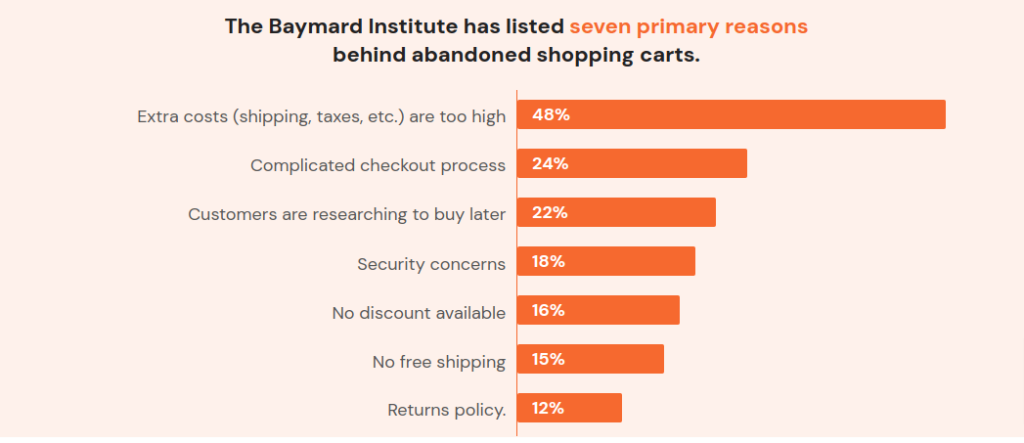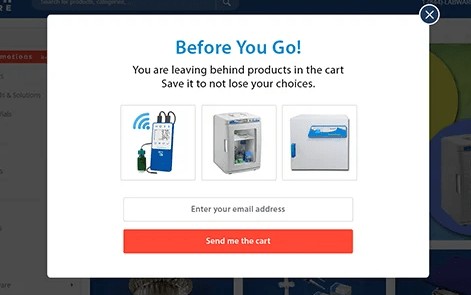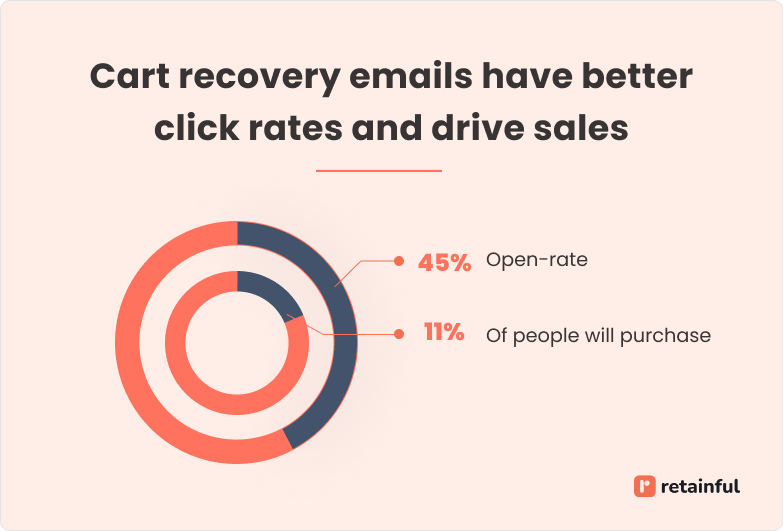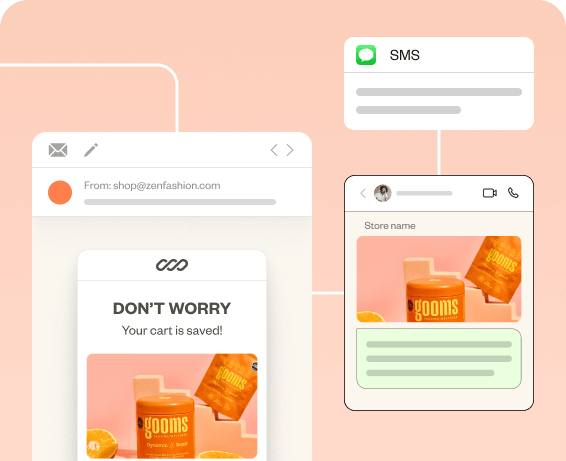Every abandoned cart means lost revenue and missed sales opportunities for your e-commerce store. So, would you miss the chance to reduce cart abandonment when it’s completely preventable?
When customers abandon their carts, it’s like a signal for you that says – there’s friction in their buying journey. It can be anything, like a complicated checkout process or unexpected high shipping costs that drive them away.
In this comprehensive guide, you’ll discover the key reasons why customers abandon carts and learn 12 proven strategies to effectively reduce cart abandonment, backed by data and trusted by leading e-commerce brands to boost conversions by up to 35%.
Let’s dive right in.
Turn abandoned carts into sales with Retainful’s one-click abandoned cart recovery.
Why Shopping Cart Abandonment Happens: Key Reasons Explained
Shopping cart abandonment in ecommerce occurs when customers encounter friction while shopping for products.
This friction leads to poor user experience and cart abandonment and resulting in customers abandoning the cart.
Understanding the reasons for cart abandonment is the first step to reducing cart abandonment effectively.
Here are the reasons for the friction that leads to shopping cart abandonment in ecommerce:

High Shipping Costs And Unexpected Fees
58% of shoppers have abandoned a cart due to high shipping costs
Nearly half of the shoppers abandon their carts due to extra costs being too high.
Unexpected fees, such as handling charges, taxes, or shipping fees that are only revealed at the final checkout stage, can create a perception of lack of transparency.
High shipping costs can drive customers to look for alternatives. They may seek other online stores that offer lower or free shipping.
Complicated Or Lengthy Checkout Process
21% of shoppers abandon their carts because the process takes too long
Checkout abandonment reduction should start at checkout, as most cart abandonment in e-commerce happens due to a lengthy checkout process that requires multiple steps and can be frustrating and time-consuming for customers. Because customers are not in for long-haul.
Here is what a complicated checkout process looks like:
- Mandatory account creation
- Multi-page form
- Lack of multiple payment options
- Slow loading times
- No progress indicator
Lack Of Trust Or Payment Security
Many customers are wary of online transactions due to the risk of credit card fraud and identity theft.
Digital shopping cart abandonment happens if a website does not seem secure or lacks clear indications of security measures.
Also, if an ecommerce site uses an unfamiliar payment gateway, customers may feel uneasy about proceeding with the transaction.
Poor website design signals unreliability. Elements such as broken links, unresponsive pages, and outdated designs can deter customers from completing their purchases.
Limited Payment And Shipping Options
Customers have diverse preferences for payment methods, including credit cards, digital wallets (like PayPal, Apple Pay), and installment payment options.
When a preferred payment method is unavailable, customers are more likely to abandon their cart out of convenience, leading to ecommerce cart abandonment. The impact of payment options on cart abandonment rates is significant in modern e-commerce.
Limited shipping options may not meet customers’ expectations for speed or cost, leading them to leave the site without completing their purchase.
Online Window Shopping
Shoppers might add items to their cart to compare prices, features, and reviews before making a decision. They are not in immediate need of the products or planning to buy in the future.
Online shopping cart drop-off reduction becomes challenging when these customers often leave the cart without checking out as they continue their search for better deals or more information elsewhere.
Out of all the reasons, this one is less likely to prevent.
How To Calculate Cart Abandonment Rate?
The cart abandonment rate is the most critical metric to track if you want to reduce cart abandonment and increase revenue. Cart abandonment analytics help track this crucial metric.
Here is the cart abandonment rate formula:
Cart Abandonment Rate Formula=(Number of Shopping Carts Created – Number of Completed Purchases) / Number of Shopping Carts Created ) ×100

When to take action?
- A bad cart abandonment rate is typically above 75%.
- Rates exceeding 80% indicate significant issues in the checkout process and user experience.
Cart abandonment rate optimization becomes essential at this point.
12 Effective Strategies to Reduce Cart Abandonment
- Optimize Your Checkout Process
- Enable Guest Checkout
- Display Clear Pricing Upfront
- Offer Multiple Payment Options
- Provide Clear Return Policies
- Offer Free Shipping
- Improve Mobile Experience
- Include Product Thumbnails In The Cart
- Exit-Intent Popups
- Provide Live Chat
- Use trust badges and security seals
- Add progress indicators
The following strategies will help you reduce cart abandonment by up to 30% within 90 days. Each tactic is proven to work across thousands of e-commerce stores:
1. Optimize Your Checkout Process
Streamline the checkout process by reducing the number of steps required to complete a purchase. This includes:
- Minimizing form fields
- Enabling auto-fill
- Using a single-page checkout
- Implement progress bars
A simplified checkout process is the fastest way to reduce cart abandonment and can improve conversions by 35.26%. Moreover, this improves the ecommerce checkout experience significantly.

2. Enable Guest Checkout
To reduce cart abandonment, let your customers check out without creating an account. According to statistics, guest checkout is one of the easiest ways to reduce cart abandonment by up to 30%.
First-time visitors are more likely to complete their purchase if they don’t have to commit to creating an account.
Provide an option to create an account after the purchase is completed. This allows customers to store their information for future use without feeling pressured during their initial purchase and reduces abandoned carts.
3. Display Clear Pricing Upfront
Surprise costs are the #1 reason customers abandon carts. Here’s how to reduce cart abandonment with transparent pricing:
Customers feel more confident in the purchase process when they see the total cost from the beginning.
The cart abandonment solution is to display estimated shipping costs on the product page or in the cart summary. Shopify recommends using geolocation tools to estimate shipping costs and display them as early as possible in the shopping process.
Calculate and display applicable taxes and any additional fees early in the checkout process. Clearly label these costs to avoid confusion and reduce abandoned carts.
Offer a detailed breakdown of all costs in the cart summary or checkout page. This should include item prices, shipping, taxes, and any other fees.
4. Offer Multiple Payment Options
Payment options to reduce cart abandonment are crucial. In fact, offering 6+ payment methods can reduce abandonment of cart.
When customers find their preferred payment method available, they are more likely to complete their purchase.
Integrate well-known payment gateways like PayPal, Stripe, and Square into your checkout process to reduce shopping cart abandonment. These gateways support multiple payment methods and are trusted by consumers worldwide.
5. Provide Clear Return Policies
Online shopping is filled with anxiety about whether or not the product will be good.
Place a link to your return policy in prominent locations on your website, such as the footer and product pages, during the checkout process. Ensure that it is easy to find and access.
A hassle-free return process contributes to higher overall satisfaction and reduces shopping cart abandonment.
6. Offer Free Shipping
You can set a minimum order amount to qualify for free shipping. This not only improves satisfaction but also increases order value.
Reduce abandoned carts by using free shipping as a promotional tool and ensure that customers are aware of it. Highlight it on the homepage, product pages, and throughout the checkout process to maximize its impact.
7. Improve Mobile Experience
According to Google, 53% of mobile site visits are abandoned if a page takes longer than three seconds to load
Mobile cart abandonment rates are 85% higher than desktop, according to 2025 data. So, mobile optimization to decrease cart abandonment is essential.
Mobile cart abandonment solutions:
- Ensure that your website adapts to different screen sizes.
- Add a responsive design that adjusts layouts, images, and content to provide a good viewing experience on any device.
8. Include Product Thumbnails In The Cart
Including product thumbnails helps customers easily identify if they have added the correct items to their cart, reducing the chance of errors and the need for returns.
Display product thumbnails in the cart, checkout page, and order confirmation emails. This consistent use of imagery helps reinforce the customer’s purchase decision at multiple stages and prevents cart abandonment.
9. Exit-Intent Popups
With timely and targeted exit-intent popups, you can capture the attention of customers who are about to leave your store without completing their purchase.
Exit-intent popups for cart recovery often include special offers, discounts, or free shipping incentives that encourage customers to complete their purchases.
How exit-intent popups help reduce cart abandonment: This last-minute nudge by exit-intent popups can be highly effective in converting hesitant shoppers and reducing the cart abandonment rate.

10. Provide Live Chat
Tips to reduce cart abandonment include implementing live chat. Customers who use chat are 2.8 times more likely to convert than those who do not.
Live chat provides customers with instant help, addressing their concerns or questions without delay. This can prevent customers from leaving the site in search of answers and reduce abandoned carts.
You can use live chat to resolve technical issues, clarify product details, or assist with payment questions. This reduces the friction in the checkout process, provides a good customer experience, and decreases cart abandonment.
11. Use Trust Badges And Security Seals
These are visual cues that show the website’s credibility and security. They reassure customers that the site is legitimate and their data is protected.
To reduce abandoned carts, select trust badges and security seals from well-known and reputable organizations – SSL certificates, payment security badges, and site security seals.
12. Add Progress Indicators
To decrease cart abandonment, use a progress indicator to show customers how many steps are left to complete the checkout process. They are more likely to complete tasks when they can see their progress visually.
This cart abandonment solution gives customers a clear overview of what to expect, including the number of steps and their labels – Shipping Information, Payment Details, Review Order.
Advanced Cart Recovery: How to Win Back Lost Sales
Now, we have strategies to prevent cart abandonment, but what about those that have already happened?
You can recover 15-25% of abandoned carts by reminding customers about their abandoned items and prompting them to finish the purchase.
Cart recovery tools for e-commerce include:
- Abandoned cart emails
- Retargeting ads
- Push notifications
Let’s see these strategies in detail.
1. Abandoned Cart Emails
Abandoned cart emails and email marketing strategies for abandoned cart recovery are the best way to reduce cart abandonment and reclaim the lost sales.
- High Engagement Rate: Abandoned cart emails have an open rate of 45% – more than any typical marketing email. Out of that, 11% resulted in the recovery of the cart.
- High Conversion Potential: An abandoned cart email campaign can recover up to 15-20% of lost sales.

These emails act as reminders, nudging the customers to return to the cart and finish their purchase. They help improve the cart conversion rate significantly.
To reduce the abandoned cart rate, you should send 3-5 emails at well-timed intervals. Each cart abandonment email should focus on different pain points and the customer’s objections.
- Email 1 – The gentle reminder (After 2 hours)
- Email 2 – The attractive incentive (After 24 hours)
- Email 3 – Evoking the urgency (After 48 hours)
- Email 4 – Sharing the social proof (After 5-7 days)
- Email 5 – The final call (After 10-14 days)
Send multiple abandoned cart emails automatically with Retainful and increase your cart recovery rate.
Retargeting ads
Retargeting ads are a cart abandonment solution that reminds customers of the abandoned cart items as they browse other websites or social media platforms.
Repeated exposure to retargeting ads keeps your brand top-of-mind and reduces shopping cart abandonment. Even if customers don’t immediately return to complete their purchase, they are more likely to remember your brand for future shopping.
You can run personalized retargeting ads that target customers’ browsing behavior and cart contents.
Use Google Ads or Facebook Ads to track customer behavior on your store and target them with specific ads based on their actions on your site.
Push notifications
Push notifications are a cart abandonment solution that delivers instant messages directly to customers’ devices and captures their attention more quickly.
It can also be personalized based on user behavior, such as the items left in the cart.
Write concise and compelling messages that include a clear call-to-action (CTA). Highlight key details such as product names, prices, and any special offers or discounts.
How can Retainful Help Reduce Abandoned Carts?
Retainful is a cart abandonment software that boasts a higher cart recovery rate than any other software on the market.
You can reduce up to 30% of abandoned carts using Retainful’s:
- One-click cart recovery
- Abandoned cart email series
- Pre-designed email templates
Here is how Retainful’s cart abandonment recovery works:
- Captures the customer’s email addresses at checkout.
- When a cart is marked as abandoned, it will automatically send the first cart reminder email to the customer, including a unique one-click recovery link.
- If the cart is not recovered, it sends the next cart recovery email in the series after the time delay you set.
Send automated abandoned cart emails with Retainful and recover up to 30% of abandoned carts.
Wrapping Up!!
Learning how to reduce cart abandonment is the first step in stopping huge revenue losses from abandoned carts.
With the above ways to reduce shopping cart abandonment, you can eliminate all frictions in the checkout process that lead to abandoned carts and stop losing sales to them.
If you are already having revenue tied in the abandoned carts, start sending abandoned cart emails to recover those.
Read more about recovering abandoned carts.
- WooCommerce Abandoned Cart: An Ultimate Guide
- How to Reduce Shopify Abandoned Carts? – Strategies + Apps
- How to send WooCommerce abandoned cart emails? A step-by-step guide
- Shopify Abandoned Cart Email – Strategies and Templates to Recover Lost Sales
Frequently Asked Questions
Send timely abandoned cart emails with personalized messages, offer discounts or incentives to encourage customers to complete their purchase.
Cart abandonment solutions to recover lost sales are abandoned cart emails, retargeting ads, designing a smooth checkout process, offering multiple payment options, and more.
Use retargeting ads on social media, send personalized emails with reminders of the abandoned items, and offer exclusive discounts or free shipping to prompt customers back to complete their purchases.
Measuring cart abandonment helps identify issues in the checkout process, understand customer behavior, improve the shopping experience, and ultimately increase conversion rates and revenue.
Send a personalized email within a few hours, include product images, offer a discount or incentive, provide a clear call-to-action, and ensure the checkout process is streamlined and user-friendly.
The recovery flow typically includes sending a series of emails or notifications: an initial reminder shortly after abandonment, a follow-up with an incentive, and a final reminder to create urgency.
Cart abandonment often occurs due to hidden costs, lack of payment options, complicated checkout processes, or simply hesitation.
Send automated abandoned cart recovery emails, offer time-limited discounts, simplify the checkout process, and provide multiple payment options to encourage customers to complete their purchase.
A normal abandoned cart rate is around 69.57%, but rates can vary by industry, with some industries experiencing rates as high as 80%.
Yes, abandoned cart recovery is worth it. It can significantly increase conversions and revenue by re-engaging potential customers who have already shown interest in your products.


